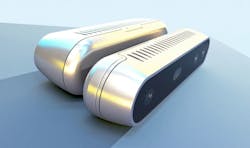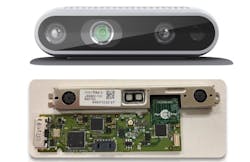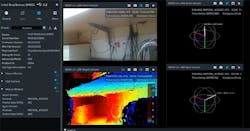Intel’s D415 and D435 RealSense 3D cameras made a splash when they were released. These low-cost, USB 3-based cameras provide a high-resolution video stream as well as a matching 3D-depth data stream that’s very handy for robots and drones. The new D435i (Fig. 1), built on the same D435 90- × 25- × 25-mm form factor, includes a Bosch inertial measurement unit (IMU).
1. The D435i (top) looks identical to the D435, but it includes a Bosch BMI055 6DOF IMU. The sensor and electronics (bottom) are available separately as well.
The D435i’s 2-Mpixel RGB camera and 3D sensor deliver 1280- × 720-pixel streams at 30 frames/s or a lower-resolution 848- × 480-pixel stream at 90 frames/s. It has a global shutter to handle faster movement and can operate indoors and outdoors. Depth range is between 0.1 and 10 m, and field-of-view is 85 × 58 degrees. It has a depth error under 2% at 2 m.
The new addition in the D435i is a Bosch BMI055 IMU with six degrees of freedom (6DOF). The IMU includes a 3D 12-bit acceleration sensor and a 16-bit, ±2000°/s gyroscope. The BMI055 is designed to deliver low-noise measurements of angular rates and acceleration. That’s akin to the 6DOF sensors in smartphones and other mobile devices.
The D435i and siblings are supported by the Intel RealSense SDK 2.0. The monitor application (Fig. 2) has been enhanced to handle the IMU data.
2. Intel’s RealSense SDK app now presents the IMU’s 3D accelerometer and gyro data (right side).
Many developers were already using the D4x5 cameras with their own external sensors. However, integrating the IMU with the 3D camera does more than just reduce the parts count. The IMU information is synchronized with the data frames generated by the 3D-depth sensor and the video image. This could allow features like image stabilization to be added as well as provide better information about the environment.
Sagi Ben Moshe, Vice President and General Manager of the Intel RealSense Group, notes, “Intel RealSense technology is used to build products that enrich peoples’ lives through devices and machines that perceive the world in 3D. With the addition of the IMU, the RealSense D435i enables developers to tackle a new set of challenges related to tracking movement and depth.”
Mixing the camera with neural networks is natural, and now IMU information can be added to the mix. Of course, this will make the machine-learning models more complex—but with the potential for providing better results.
The D435i will be used in a wide range of applications in addition to robotics. The IMU will also be useful for rotational tracking in augmented-reality (AR) and virtual-reality (VR) head-mounted displays.
About the Author
William G. Wong
Senior Content Director - Electronic Design and Microwaves & RF
I am Editor of Electronic Design focusing on embedded, software, and systems. As Senior Content Director, I also manage Microwaves & RF and I work with a great team of editors to provide engineers, programmers, developers and technical managers with interesting and useful articles and videos on a regular basis. Check out our free newsletters to see the latest content.
You can send press releases for new products for possible coverage on the website. I am also interested in receiving contributed articles for publishing on our website. Use our template and send to me along with a signed release form.
Check out my blog, AltEmbedded on Electronic Design, as well as his latest articles on this site that are listed below.
You can visit my social media via these links:
- AltEmbedded on Electronic Design
- Bill Wong on Facebook
- @AltEmbedded on Twitter
- Bill Wong on LinkedIn
I earned a Bachelor of Electrical Engineering at the Georgia Institute of Technology and a Masters in Computer Science from Rutgers University. I still do a bit of programming using everything from C and C++ to Rust and Ada/SPARK. I do a bit of PHP programming for Drupal websites. I have posted a few Drupal modules.
I still get a hand on software and electronic hardware. Some of this can be found on our Kit Close-Up video series. You can also see me on many of our TechXchange Talk videos. I am interested in a range of projects from robotics to artificial intelligence.




